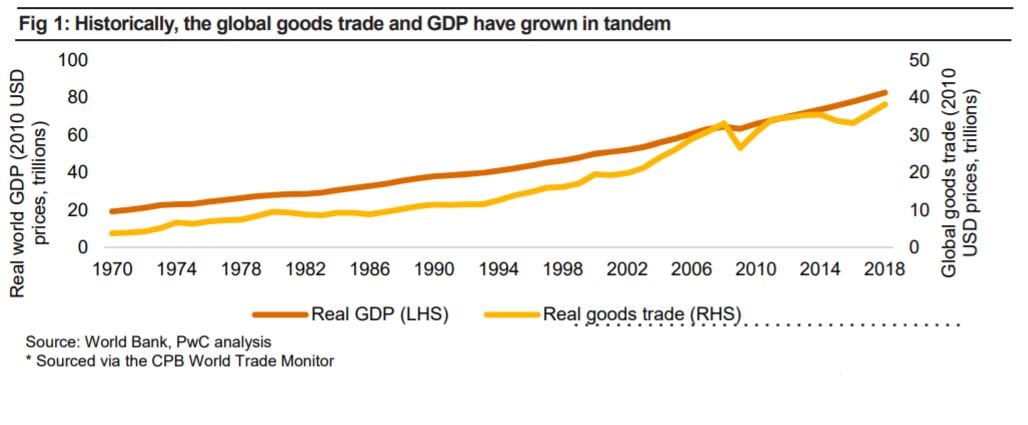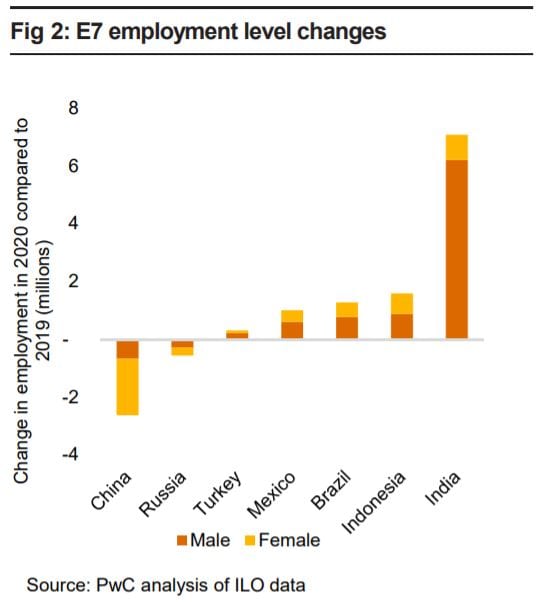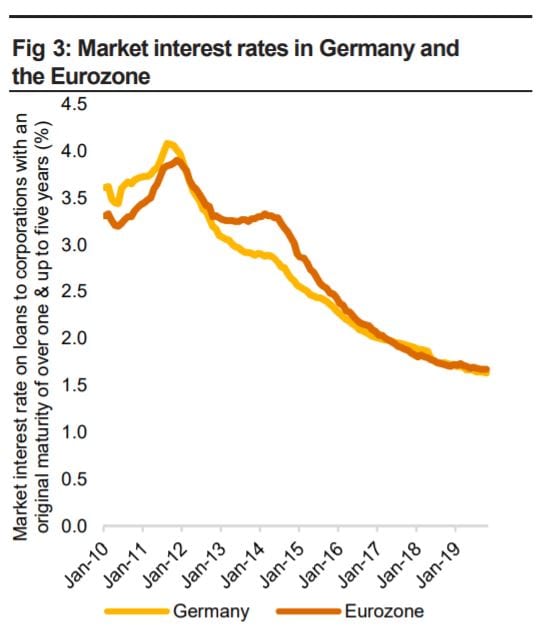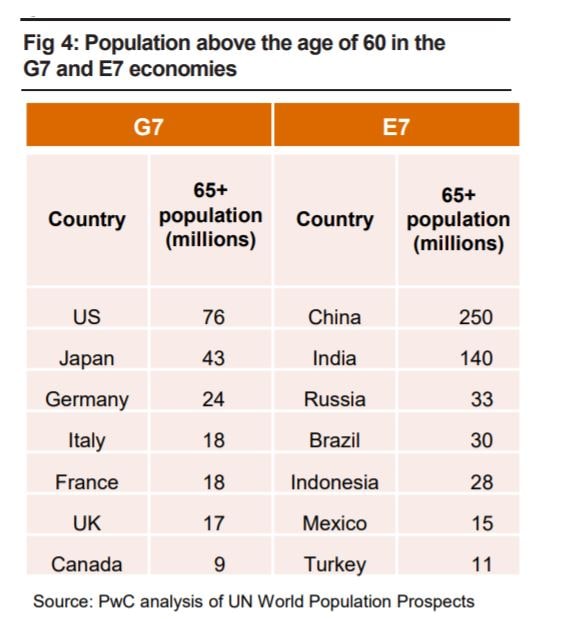
Projecting what the future holds is an important exercise for businesses looking to plan ahead. Below we present a summary of some of the themes we assess will likely prevail in the global economy in 2020.
Trading goods across borders will likely remain tense…: A defining feature of the global economy since at least the 1970’s has been globalisation—the bringing together of economies predominantly via more liberal trade flows. The global volume of merchandise traded slowed down dramatically and even went in reverse in 2019 in contrast to a 21st century average growth rate of about 3.4% per annum*. Also, in December 2019 the World Trade Organization’s (“WTO”) dispute settlement mechanism was effectively disbanded. We expect this trend to continue in 2020 and for trade tensions in the global goods market to persist. This means that we assess globalisation is likely give way to ‘slowbalisation’ i.e. continued integration of the global economy via trade, financial and other flows but albeit at a significantly slower pace. Large businesses with sophisticated supply chains spread across the world should therefore plan for a variety of scenarios, some of which have not been experienced in recent history.
…but global services trade expected to hit US$7 trillion: One aspect of trade that is often neglected is trade in services, which is now about one third of the size of the global volume of merchandise trade. In contrast to goods, services remain largely unaffected from tariff wars. The latest 2018 data from the International Trade Centre (“ITC”) shows that the global export of services was worth about US$5.8 trillion, or around 3.5% of global GDP. We expect the total value of services exported to hit a record US$7 trillion by 2020. Assuming historic trends continue, the US and UK are likely to remain the first and second largest exporters of services in the world in US Dollar terms. But in yet another reminder of the shift of the centre of economic power from the West to the East we expect China to overtake France in 2020 and become the world’s fourth largest services exporter.
Global economy is expected to grow at a modest pace: Figure 1 shows that growth in merchandise trade flows and the global economy have been intrinsically linked. In our main scenario for 2020, we expect the global economy to expand at a rate of around 3.2% in purchasing power parity (“PPP”) terms which is below the 21st century average of 3.8% per annum. In our main scenario, we expect all of the major economies to grow, buoyed, in part, by accommodative financial conditions. US economic activity is likely to expand by around 2%, in line with its potential rate. Given the historically low unemployment rate, US employers, however, find it increasingly difficult to hire staff. Across the pond, the Eurozone is expected to grow at approximately half that rate (i.e. around 1%). Germany, and other economies that are sensitive to global trade flows, to become more reliant on household consumption as a source of growth instead of net exports and investment. For Germany, however, this could be challenging as households tend to save more than the European average. In the emerging world, we expect the Chinese economy to expand by less than 6%-- but it can still add the equivalent of Saudi Arabia to the world economy in one year. The world’s six other largest emerging economies, including Turkey, should also grow in this scenario, with India leading the way.

Predictions for 2020
More jobs across the board but not necessarily spread equitably
We expect the G7 to continue to create jobs, to the tune of around 2 million. Four out of the five new jobs in the G7 will be created in the US, UK and Japan. As the pool of labour resources in the G7 gradually dries up, we assess earnings should continue their upward trajectory. But in the absence of productivity improvements, corporate profit margins could be squeezed. Similarly, the International Labour Organization (“ILO”) expects the seven largest emerging economies– the E7–to create about 8 million jobs in net terms. There are some exceptions to this– Russia and China are likely to experience a shrinking workforce because of demographic pressures. Finally, the ILO’s employment projections for the G7 show that jobs are likely to be taken up by men and women in equal measure. Within the E7, however, the ILO expects job creations to be less evenly distributed across genders.

India expected to rise in global economic rankings
According to the IMF’s latest estimates, 2019 was the year when India overtook the UK and France to become the fifth largest economy in the world. This is an ongoing process with India likely on current trends to overtake Germany before 2025 and Japan before 2030 to become the world’s largest economy behind China and the US. France and the UK will likely now vie for sixth place in the rankings, with their relative position dependent on the value of the pound against the euro which may remain volatile in 2020.
Germany may need to choose between ‘lower for longer’ interest rates or higher fiscal spending
The US is expected to run a US$1.2 trillion government deficit. The Eurozone, which is about the same size as the US economy will run a government deficit about 1/10 the size of the US. In fact, we expect almost half of the Eurozone member states to run a government budget surplus in 2020. Cyprus, Luxembourg and Germany are expected to run the largest surplus relative to their economic size while France and Italy are expected to be on the opposite end of the spectrum with continuing budget deficits. Germany is likely to come under renewed pressure to either increase its government spending or accept ‘lower for longer’ interest rates (see Figure 3). Further afield, of the Gulf Cooperation Council (“GCC”) countries, we only expect Qatar to run a government surplus in 2020. This could mean more policy action in the future to balance government budgets across the GCC.

Source: ECB
US oil production expected to hit record levels
Global renewable energy and nuclear consumption will likely make up more than 20% of global energy consumption, which is the highest it has ever been. The rise of renewable energy reflects how businesses, households and governments are adapting and changing their attitudes. China is expected to be the largest consumer of this type of energy closely followed by Europe. However, oil is expected to continue to remain the most preferred source of energy in 2020 for the world economy followed by coal and natural gas. The US and China will almost certainly remain the largest consumers of oil in the world in 2020. In so far as the extraction and supply of oil (and other liquid forms of energy) is concerned the US may surpass the monthly 13 million barrels per day (“b/d”) threshold. To set into context, in the US crude oil was extracted at a rate of 5.5 million b/d 10 years ago.
Global population biggest it has ever been but also the greyest
According to the United Nations (“UN”), In 2020, the world’s population is expected to reach 7.7 billion, which is around a 10% increase compared to a decade ago. China, India and SubSaharan Africa are expected to drive around half of the world’s annual population increase. At the same time, the number of people above the age of 60 globally is expected to surpass the one billion mark. China is expected to have a larger number of people above the age of 65 than all the six other largest emerging economies put together. This calls into question how policymakers respond to this trend and fund future health and social care. This could also be an opportunity for businesses in advanced economies, who have been dealing with such issues for decades. In relative terms i.e. the proportion of people above the age of 65 relative to the country’s entire population, Japan is expected to remain the ‘greyest’ country in the world and Niger is expected to be the youngest.

Further predictions for 2020
- At the Euro 2020 (also known as the UEFA European Football Championship) which will be hosted in a total of 12 countries between June and July we expect the Netherlands to win the championship.
- As a further sign of the increased levels of automation across most industries, we expect the operational stock of robots to exceed the 2.6 million mark in 2020. This implies some moderation in relative to the historic growth rate on the back of the trade tensions which has affected industries which rely on robotic technology.
- According to the IMF, Guyana is expected to be the fastest growing economy in the world, on the back of starting oil production in 2020. On the other end of the spectrum, Venezuela’s economy is expected to contract by around 10%.
- More than half a billion people are expected to live in the 30 largest cities of the world. Of these cities, five are expected to be in the G7 economies whereas the rest are expected to be in mostly emerging economies. According to the UN, Tokyo is expected to be the largest city in the world in terms of population, followed by Delhi and Shanghai.

















